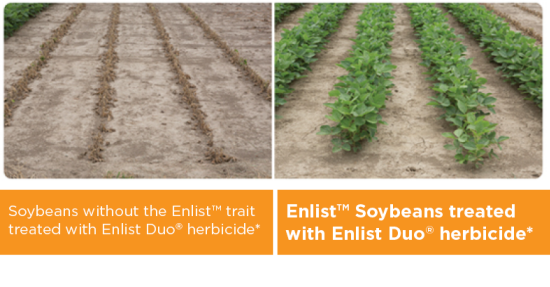|
 Enlist One is a straight
broadleaf control herbicide with an impressive list of hard to kill
weeds such as Palmer Amaranth, Waterhemp, Giant Ragweed,
Lambsquarters, Marestail, Morning Glory Velvet Leaf, Velvet Leaf and
Common Ragweed. Enlist One is a straight
broadleaf control herbicide with an impressive list of hard to kill
weeds such as Palmer Amaranth, Waterhemp, Giant Ragweed,
Lambsquarters, Marestail, Morning Glory Velvet Leaf, Velvet Leaf and
Common Ragweed.
Enlist Duo offers the same broadleaf control and adds to it
glyphosate for control of grasses.
A big hurdle for any GMO seed in the U.S. is the acceptance of the
end product in China.
While crops are still grown in the U.S. that are not acceptable in
the China market, extensive control measures are practiced getting
those crops to market. Receiving the China stamp of approval on
Enlist corn and now for Enlist soybeans makes it easier for local
producers to grow and sell GMO grains.
The Enlist GMO seed corn and Enlist chemical herbicides combination
were marketed to producers in 2018 after being approved by China in
June of 2017.
In January of 2019, China also agreed to accept the Enlist GMO
soybeans, paving the way for widespread marketing in 2020.

“We are very excited to bring the Enlist
system to farmers in the U.S. and Canada,” said Dow AgroSciences
President and CEO Tim Hassinger in 2017. “The feedback on the
performance during our Stewarded Introduction has been extremely
positive, as growers have been very impressed with both the weed
control as well as the formulation advancements we have made,
reducing the potential for drift and volatility.”
There are many advantages to the new Enlist combinations starting
with what Dow considers to be superior weed control. Through that
control, producers anticipate higher yields as hard-to-kill weeds no
longer rob fields of moisture and nutrients.
[Additionally, the Enlist herbicides are reported to have easier
application with better drift control.]
In August of 2017, Dow officials made the following statement in an
article published in Successful Farming.
“The Enlist Duo herbicide that contains 2,4-D choline has 87% and
96% reduction in volatility compared with existing 2,4-D amine and
2,4-D ester formulations, respectively. Meanwhile, Enlist Duo cuts
drift potential 90% compared with older 2,4-D formulations when
applied using low-drift-potential nozzles, say Dow officials.”
The label recommends spraying the product in wind speeds between
three and 10 miles per hour. They caution the products should not be
applied in wind speeds of 15 miles per hour or higher. It is also
recommended that wind directions should be moving away from
susceptible crops including vegetables and fruits.

There are also serious warnings regarding temperature inversion and
the company is adamant that the wind speed should be at least three
miles per hour to avoid suspension of the product in the warmer air
masses.
From the Enlist website: A temperature
inversion occurs when a layer of warm air covers a layer of cooler
air and acts like a lid, preventing the cooler air from rising and
dissipating into the upper atmosphere.
During a temperature inversion, spray particles can become trapped
in the warmer layer of air and stay suspended until the wind
increases. Gases, then, can move off target into neighboring fields,
lawns and gardens and may cause injury to susceptible crops.
Calm winds, clear skies and long nights increases the likelihood of
a temperature inversion occurring.
Temperature inversions often form when:
- Wind speeds are 3 mph or less
- During late evening or early mornings when temperatures are within
5 degrees of the nighttime low
- Fog is visible during dawn or dusk.
“We want a light wind — 3 to 10 miles per hour — when making a
herbicide application,” says Haley Nabors, herbicide trait field
specialist. Within a temperature inversion, applied products can
move great distances.
“Furthermore, the direction the trapped air will move is
unpredictable.”
The herbicide products are also reported to be easy to use in tank
mixes with other herbicide, insecticides, and fungicides on the
acceptable to use lists published on the Enlist website.
To see the full list for Enlist One visit this page -
https://www.enlist.com/en/ approved-tank-mixes/enlist-one.html
For Enlist Duo another page is available -
https://www.enlist.com/en/approved-tank-mixes/enlist-duo.html
So, how does this work on
the seed side?
To use Enlist herbicide the producer must use the Enlist tolerant
seed. This is seed that has been genetically modified so that Enlist
(chemicals) will kill the weeds in the field without killing the
crop. The use of Enlist on non-Enlist seed is not pretty.
[to top of second column] |


This image found on the Ohlde
Seed company website demonstrates what is going to happen if Enlist
is applied to soybeans that have not been modified with the Enlist
trait.
So what is the ‘trait’ that makes the soybeans resistant?
Dr. Bob Hartzler, a professor of agronomy and an extension weed
specialist at Iowa University offered a this explanation of the
trait. “Dow scientists identified a class
of bacterial enzymes (AADs) that metabolize 2,4-D. The gene for this
enzyme was inserted into crops, therefore providing resistance to
2,4-D in soybean and greatly increasing corn’s tolerance to this
herbicide. The trait is referred to as Enlist.”
In his article, “Why in the
World is Enlist Corn Resistant to the Fop Herbicides?” Hartzler did
note one concern with the new seed corn and accompanying herbicide.
He was puzzled by the resistance to Fop herbicides that was bred
into the seed. These popular herbicides include Assure II, Fusilade
and Hoelon, which are beneficial in the second season when that
volunteer corn comes up in the fields. With a resistance to these
chemicals Enlist corn that comes up volunteer is going to be a
challenge.

Hartzler researched further and came up with the following
explanation: “Dow scientists identified a
version of the AAD enzyme that not only metabolized 2,4-D, but also
degrades the ‘fop’ herbicides. This ability is due to the ‘fops’
having a bond nearly identical to one present in 2,4-D. They chose
to use this version of the enzyme in Enlist corn due to concerns
that glyphosate resistant grasses would be widespread by the time
Enlist crops reached the market. This would allow the ‘fops’ to be
used to control grasses no longer controlled by glyphosate.
Fortunately, the ‘dim’ herbicides (Poast and Select for example) do
not have this bond so they remain an effective tool to control
volunteer corn with the Enlist trait.”
In conclusion, at the moment at least, there appear to be very few
negatives in utilizing the new GMO corn and soybeans coupled with
Enlist herbicides. The advantages to use of this new combination are
big - from ease of application, to versatility with other tank
mixes, better drift control, superior weed control, and expectations
of higher yields, Enlist appears to be the next best new tool in the
tool box for agricultural productivity and profitability.
Resources
Dow Announces Launch of Enlist Corn in U.S. and Canada
https://www.corteva.com/resources/media-center/dow-announces-launch-of-enlist-corn-in-us-and-canada.html
June 2017
What the Enlist System Does
https://www.agriculture.com/ crops/
soybeans/dow-s-enlist-system-a-go-for-corn-in-2018-still-waiting-for-soybeans
August 2017
Why in the World is Enlist Corn Resistant to the Fop Herbicides?
- added information from Dow Agro Sciences
https://agfax.com/2015/02/02/iowa-why-is-enlist-corn-resistant-to-the-fop-herbicides/
Feb 2015
Dow’s Enlist System is a Go for Corn in 2018
https://www.agriculture.com/ crops/
soybeans/dow-s-enlist-system-a-go-for-corn-in-2018-still-waiting-for-soybeans
China Approves Enlist E3 Soybeans
https://www.agweb.com/article/china-approves-enlist-e3-soybeans/
Jan 2019
|